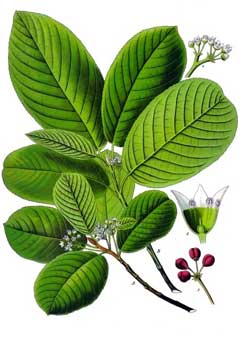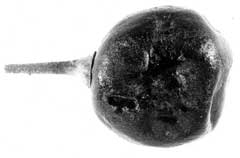 |
|
http://commons.wikimedia.org/wiki/File:Koeh-121.jpg |
 |
| USDA-NRCS PLANTS Database |
Translate this page:
Summary
UPDATE 15/2/2012: Rhamnus purshiana DC. is a synonym of Frangula purshiana Cooper
Physical Characteristics

 Frangula purshiana is an evergreen Tree growing to 10 m (32ft) by 6 m (19ft).
Frangula purshiana is an evergreen Tree growing to 10 m (32ft) by 6 m (19ft).
See above for USDA hardiness. It is hardy to UK zone 7. It is in leaf all year, in flower from May to June, and the seeds ripen in October. The species is hermaphrodite (has both male and female organs) and is pollinated by Insects.
It is noted for attracting wildlife.
Suitable for: light (sandy), medium (loamy) and heavy (clay) soils. Suitable pH: mildly acid, neutral and basic (mildly alkaline) soils. It can grow in semi-shade (light woodland) or no shade. It prefers moist soil.
UK Hardiness Map
US Hardiness Map
Synonyms
Frangula purshiana. (DC.)Cooper., Rhamnus purshiana
Plant Habitats
Edible Uses
Fruit - raw or cooked[2, 118, 161, 257]. A thin, rather juicy flesh[82]. It is sometimes eaten[183]. There is some debate as to whether the fruit is edible or slightly toxic[226]. The fruit is about 10mm in diameter[200] and contains 2 - 3 small seeds[229]. An extract of the bark, with the bitterness removed (by drying?) is a common flavouring for soft drinks, baked goods and ice cream[183].
References More on Edible Uses
Medicinal Uses
Plants For A Future can not take any responsibility for any adverse effects from the use of plants. Always seek advice from a professional before using a plant medicinally.
Cascara sagrada is widely used as a gentle laxative that restores tone to the bowel muscles and thus makes repeated doses unnecessary[226, 244]. It is often sold in chemists etc[226]. The bark is used, this is harvested on a commercial basis from wild trees and plantations in western N. America[226]. It should be harvested in the autumn or spring at least 12 months before it is used medicinally, in order to allow the more violent purgative effect to be mollified with age[95, 213]. Three year old bark is considered to be the best age[4]. It is considered suitable for delicate and elderly persons and is very useful in cases of chronic constipation[4]. The bark also has tonic properties, promoting gastric digestion and appetite[1, 4, 11, 21, 57, 94, 95, 165]. As well as its uses as a laxative, it is taken internally in the treatment of digestive complaints, haemorrhoids, liver problems and jaundice[238]. This remedy should be used with caution since in excess it causes vomiting and diarrhoea[238]. It should not be prescribed for pregnant or lactating women, or patients with intestinal obstruction[238]. An infusion of the bark is sometimes painted over finger nails in the hope that the bitter taste will deter the person from biting their nails[238]. The German Commission E Monographs, a therapeutic guide to herbal medicine, approve Rhamnus purshiana for constipation (see [302] for critics of commission E).
References More on Medicinal Uses
The Bookshop: Edible Plant Books
Our Latest books on Perennial Plants For Food Forests and Permaculture Gardens in paperback or digital formats.

Edible Tropical Plants
Food Forest Plants for Hotter Conditions: 250+ Plants For Tropical Food Forests & Permaculture Gardens.
More

Edible Temperate Plants
Plants for Your Food Forest: 500 Plants for Temperate Food Forests & Permaculture Gardens.
More

More Books
PFAF have eight books available in paperback and digital formats. Browse the shop for more information.
Shop Now
Other Uses
A green dye is obtained from the bark[99, 118, 257]. Plants are sometimes grown in America as an ornamental hedge[229]. Wood - light, soft, not strong. Used for making the handles of small tools[82, 99].
Special Uses
References More on Other Uses
Cultivation details
Succeeds in any reasonably good soil in sun or partial shade[11, 238]. This species is hardy to at least -15°c[238]. Closely related to R. frangula[11]. This species is cultivated as a medicinal plant in N. America[57, 60, 61] and is also collected from the wild[238]. It is becoming rare in the wild because of over-collection[238]. The flowers are produced in small clusters on shoots of the current year's growth[82]. A good bee plant[94]. The species in this genus are notably resistant to honey fungus[200].
References Carbon Farming Information and Carbon Sequestration Information
Temperature Converter
Type a value in the Celsius field to convert the value to Fahrenheit:
Fahrenheit:
The PFAF Bookshop
Plants For A Future have a number of books available in paperback and digital form. Book titles include Edible Plants, Edible Perennials, Edible Trees,Edible Shrubs, Woodland Gardening, and Temperate Food Forest Plants. Our new book is Food Forest Plants For Hotter Conditions (Tropical and Sub-Tropical).
Shop Now
Plant Propagation
Seed - best sown in the autumn in a cold frame. Stored seed will require 1 - 2 months cold stratification at about 5° and should be sown as early in the year as possible in a cold frame or outdoor seedbed[200]. Prick out the seedlings into individual pots when they are large enough to handle, and grow them on in the greenhouse or cold frame for their first winter. Plant them out in late spring or early summer of the following year. Cuttings of half-ripe wood, July/August in a frame[113]. Cuttings of mature wood of the current year's growth, autumn in a frame. Layering in early spring[4].
Other Names
If available other names are mentioned here
Native Range
Coming Soon
Weed Potential
Right plant wrong place. We are currently updating this section.
Please note that a plant may be invasive in one area but may not in your area so it's worth checking.
Conservation Status
IUCN Red List of Threatened Plants Status :

Growth: S = slow M = medium F = fast. Soil: L = light (sandy) M = medium H = heavy (clay). pH: A = acid N = neutral B = basic (alkaline). Shade: F = full shade S = semi-shade N = no shade. Moisture: D = dry M = Moist We = wet Wa = water.
Now available:
Food Forest Plants for Mediterranean Conditions
350+ Perennial Plants For Mediterranean and Drier Food Forests and Permaculture Gardens.
[Paperback and eBook]
This is the third in Plants For A Future's series of plant guides for food forests tailored to
specific climate zones. Following volumes on temperate and tropical ecosystems, this book focuses
on species suited to Mediterranean conditions—regions with hot, dry summers and cool, wet winters,
often facing the added challenge of climate change.
Read More
Expert comment
Author
DC.
Botanical References
1160200
Links / References
For a list of references used on this page please go here
Readers comment
| Add a comment |
|
If you have important information about this plant that may help other users please add a comment or link below. Only comments or links that are felt to be directly relevant to a plant will be included. If you think a comment/link or information contained on this page is inaccurate or misleading we would welcome your feedback at [email protected]. If you have questions about a plant please use the Forum on this website as we do not have the resources to answer questions ourselves.
* Please note: the comments by website users are not necessarily those held by PFAF and may give misleading or inaccurate information.
To leave a comment please Register or login here All comments need to be approved so will not appear immediately.
|
Subject : Frangula purshiana
|
|
|
|